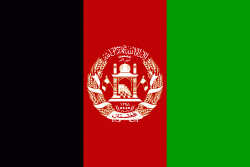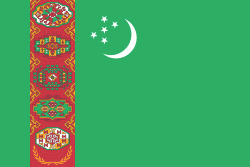Turkmen language
Turkmen (türkmençe, түркменче, تۆرکمنچه, or türkmen dili, түркмен дили, تۆرکمن ديلی, ), sometimes referred to as "Turkmen Turkic" or "Turkmen Turkish", is a Turkic language spoken by the Turkmens of Central Asia, mainly of Turkmenistan, Iran, and Afghanistan. It has an estimated 5 million native speakers in Turkmenistan, a further 719,000 speakers in northeastern Iran, and 1.5 million people in northwestern Afghanistan. Turkmen has official status in Turkmenistan, but it does not have official status in Iran and Afghanistan, where big communities of ethnic Turkmens live. Turkmen is also spoken to lesser varying degrees in Turkmen communities of Uzbekistan and Tajikistan and by diaspora communities, primarily in Turkey and Russia.
Turkmen is a member of the Oghuz branch of the Turkic languages. The standardized form of Turkmen (spoken in Turkmenistan) is based on the Teke dialect, while Iranian Turkmen use mostly the Yomud dialect, and Afghan Turkmen use the Ersary variety. Turkmen is closely related to Azerbaijani, Crimean Tatar, Gagauz, Qashqai, and Turkish, sharing varying degrees of mutual intelligibility with each of those languages. However, the closest language of Turkmen is considered Khorasani Turkic, spoken in northeastern regions of Iran and with which it shares the eastern subbranch of Oghuz languages, as well as Khorazm, the Oghuz dialect of Uzbek language spoken mainly in Khorezm along the Turkmenistan border.
Elsewhere in Iran, the Turkmen language comes second after the Azerbaijani language in terms of the number of speakers of Turkic languages of Iran.
Iraqi and Syrian "Turkmen" speak dialects that form a continuum between Turkish and Azerbaijani, in both cases heavily influenced by Arabic. These varieties are not Turkmen in the sense of this article.
The Turkmen language, unlike other languages of the Oghuz branch, preserved most of the unique and archaic features of the language spoken by the early Oghuz Turks, including phonemic vowel length.
Turkmen is a member of the East Oghuz branch of the Turkic family of languages; its closest relatives being Turkish and Azerbaijani, with which it shares a relatively high degree of mutual intelligibility. However, the closest language of Turkmen is considered Khorasani Turkic with which it shares the eastern subbranch of Oghuz languages and Khorazm, spoken mainly in northwestern Uzbekistan.
Turkmen has vowel harmony, is agglutinative and has no grammatical gender. Word order is subject–object–verb.
Written Turkmen today is based on the Teke (Tekke) dialect. The other dialects are Nohurly, Ýomud, Änewli, Hasarly, Nerezim, Gökleň, Salyr, Saryk, Ärsary and Çowdur. The Teke dialect is sometimes (especially in Afghanistan) referred to as "Chagatai", but like all Turkmen dialects it reflects only a limited influence from classical Chagatai.
Turkmen is a member of the Oghuz branch of the Turkic languages. The standardized form of Turkmen (spoken in Turkmenistan) is based on the Teke dialect, while Iranian Turkmen use mostly the Yomud dialect, and Afghan Turkmen use the Ersary variety. Turkmen is closely related to Azerbaijani, Crimean Tatar, Gagauz, Qashqai, and Turkish, sharing varying degrees of mutual intelligibility with each of those languages. However, the closest language of Turkmen is considered Khorasani Turkic, spoken in northeastern regions of Iran and with which it shares the eastern subbranch of Oghuz languages, as well as Khorazm, the Oghuz dialect of Uzbek language spoken mainly in Khorezm along the Turkmenistan border.
Elsewhere in Iran, the Turkmen language comes second after the Azerbaijani language in terms of the number of speakers of Turkic languages of Iran.
Iraqi and Syrian "Turkmen" speak dialects that form a continuum between Turkish and Azerbaijani, in both cases heavily influenced by Arabic. These varieties are not Turkmen in the sense of this article.
The Turkmen language, unlike other languages of the Oghuz branch, preserved most of the unique and archaic features of the language spoken by the early Oghuz Turks, including phonemic vowel length.
Turkmen is a member of the East Oghuz branch of the Turkic family of languages; its closest relatives being Turkish and Azerbaijani, with which it shares a relatively high degree of mutual intelligibility. However, the closest language of Turkmen is considered Khorasani Turkic with which it shares the eastern subbranch of Oghuz languages and Khorazm, spoken mainly in northwestern Uzbekistan.
Turkmen has vowel harmony, is agglutinative and has no grammatical gender. Word order is subject–object–verb.
Written Turkmen today is based on the Teke (Tekke) dialect. The other dialects are Nohurly, Ýomud, Änewli, Hasarly, Nerezim, Gökleň, Salyr, Saryk, Ärsary and Çowdur. The Teke dialect is sometimes (especially in Afghanistan) referred to as "Chagatai", but like all Turkmen dialects it reflects only a limited influence from classical Chagatai.
Country
-
Afghanistan
Afghanistan, officially the Islamic Emirate of Afghanistan, is a landlocked country located at the crossroads of Central Asia and South Asia. Referred to as the Heart of Asia, it is bordered by Pakistan to the east and south, Iran to the west, Turkmenistan to the northwest, Uzbekistan to the north, Tajikistan to the northeast, and China to the northeast and east. Occupying 652864 km2 of land, the country is predominantly mountainous with plains in the north and the southwest, which are separated by the Hindu Kush mountain range. Kabul is the country's largest city and serves as its capital. , Afghanistan's population is 40.2 million (officially estimated to be 32.9 million ), composed of ethnic Pashtuns, Tajiks, Hazaras, Uzbeks, Turkmens, Qizilbash, Aimak, Pashayi, Baloch, Pamiris, Nuristanis, and others.
Human habitation in Afghanistan dates back to the Middle Paleolithic era, and the country's strategic location along the historic Silk Road has led it to being described, picturesquely, as the ‘roundabout of the ancient world’. Popularly referred to as the graveyard of empires, the land has historically been home to various peoples and has witnessed numerous military campaigns, including those by the Persians, Alexander the Great, the Maurya Empire, Arab Muslims, the Mongols, the British, the Soviet Union, and most recently by a US-led coalition. Afghanistan also served as the source from which the Greco-Bactrians and the Mughals, amongst others, rose to form major empires. The various conquests and periods in both the Iranian and Indian cultural spheres made the area a center for Zoroastrianism, Buddhism, Hinduism, and later Islam throughout history. -
Turkmenistan
Turkmenistan ( or ; Türkmenistan / Түркменистан, ) is a country located in Central Asia, bordered by Kazakhstan to the northwest, Uzbekistan to the north, east and northeast, Afghanistan to the southeast, Iran to the south and southwest and the Caspian Sea to the west. Ashgabat is the capital and largest city. The population is about 6 million, the lowest of the Central Asian republics, and Turkmenistan is one of the most sparsely populated nations in Asia.
Turkmenistan has long served as a thoroughfare for other nations and cultures. Merv is one of the oldest oasis-cities in Central Asia, and was once the biggest city in the world. It was also one of the great cities of the Islamic world and an important stop on the Silk Road. Annexed by the Russian Empire in 1881, Turkmenistan figured prominently in the anti-Bolshevik movement in Central Asia. In 1925, Turkmenistan became a constituent republic of the Soviet Union, the Turkmen Soviet Socialist Republic (Turkmen SSR); it became independent after the dissolution of the Soviet Union in 1991.
